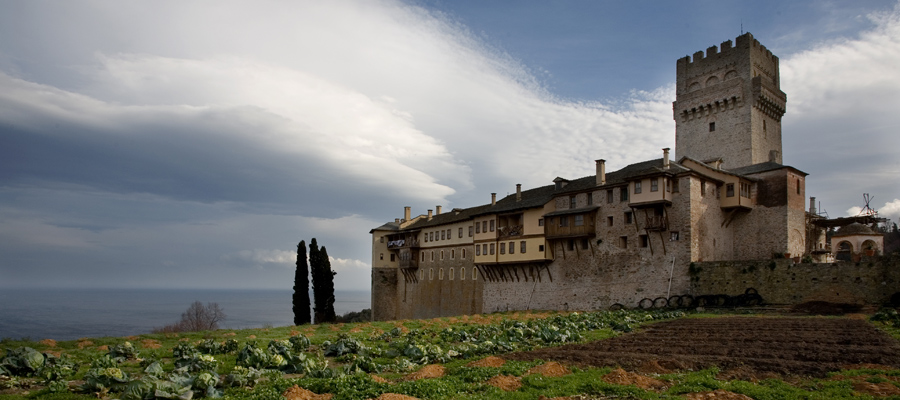Karakalou monastery
It is located on a green slope, in the northeastern side of Athos, between Megisti Lavra and Iviron monastery and has a dominant defense tower over its entrance. Its connection to emperor Karakalas is probably void. Its founding years remain unknown and its existence is firstly recorded in 1018, in a manuscript of Protaton, defining its borders. According to tradition, monk Nicholaos of the Karakalas family from Dimitsana is its founder. During the 13th century, the Karakalou monastery, as well as the other monasteries, suffered the raids of Catalan pirates and went into decline. In 1294, it received the financial support of Andronikos II Palaiologos and acquired dependencies outside Mount Athos.
Moldovan abbot John Peter Rares renovated it in the 16th century, after being pillaged by the pirates. He built the Catholicon, and the two defensive towers. In the middle of the 17th century, it was led to period of great prosperity by the support of Iberian ruler Artchil and his brother George Vachtag (1674), and according to testimonies, its population reached 500 monks. During the 1821 Revolution, the monastery collaborated with the insurgents. Monks say that abbot Damaskinos was dismissed from the monastery because he gifted a beautiful horse to warlord Tsamis Karatasos.
The Catholicon, typical sample of Athonite style, was built between 1548-1563 and honors St. Peter and St. Paul. A bell tower was added in 1710 and the outside narthex in 1714. The entrance of the temple has wooden door panels crafted by monk Theofanis in 1592. The frescoes are dated in 1716 and were made by monks John and Damaskinos. A portable picture of the twelve Apostles located in the chancel and created by famous monk painter Dionysius of Fourna (1722), has an important artistic value. Several manuscripts are preserved in the library, some of which are a 9th century parchment scroll that contains the Divine Liturgy of John Chrysostom and a Tetraevangelio (Four Gospels) written with capital letters.
A tower with its outwork and its battlement dominates in the arsana (harbor). The sign says: “the tower and the arbakas were built in the year 1534”. Ports were building complexes of vital importance for the communication and the preservation of the monasteries.
Text: Dr. Antonios G. Dikaios/ Theologian – Environmentalist.






